There is a dive site off the New Jersey coast that I have been wanting to visit since I first heard of it. There are a lot of reasons that I haven’t gotten there. I had plans for the places that I wanted to visit today but as soon as we stuck our nose out of Manasquan Inlet, I changed my priorities. I decided to head north about twelve miles to dive on two steam locomotives that sit upright in 80’ of water off Long Branch, New Jersey. My reason for heading there today is because the seas were flat calm and it would be necessary to do a buoy dive on the site.
For non-divers, a normal New Jersey dive means grappling or tying into a dive site and following the anchor line to the bottom and returning the same way. It is not possible to do this at this site because in 2004, the locomotives were “arrested”. In early September 2004, a federal judge ordered that the locomotives were to be protected. This was to follow with a federal marshal making a dive on the site and placing a laminated notice on one of the locomotives stating that tampering with or poaching is illegal. The reason behind this was to keep SCUBA divers from stripping any artifacts off the locomotives before they could be raised and restored. Two groups of amateur historical and diving enthusiast groups obtained the order and they are hoping to raise and restore the locomotives. Personally, I don’t think that this is ever going to happen but I am not against their obtaining the protection from the federal court. I think that it will be too costly to undertake such a raising and restoration. On the other hand, I did hear today that there might be something in the works to raise the locomotives. I wish them luck but I would personally like to see them stay where they are. It is believed that these locomotives were built in the 1850’s. There isn’t much data about locomotives from that era so they are an interesting historical find. The locomotives have a 2-2-2 (oOo little wheel-big wheel-little wheel) wheel layout which was rare in the United States. It was a more common layout in Europe. You can read more about the locomotives as well as see information about a Discovery Channel show at Rich Galiano’s njscuba.net web site. The page for the locomotives can be found here.
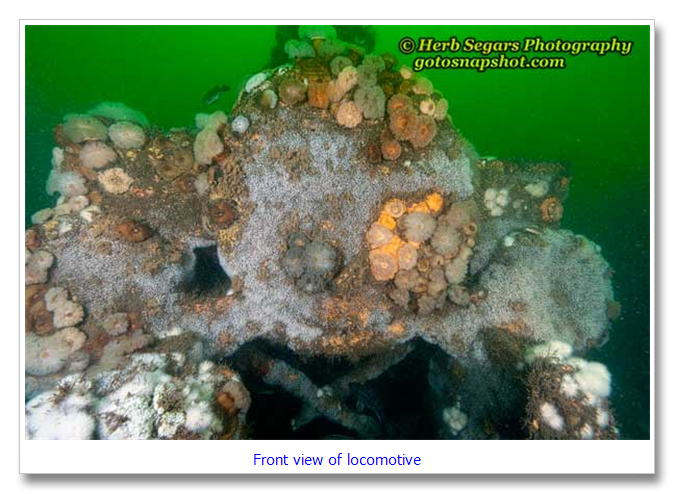
Having the locomotives protected does not prohibit SCUBA divers from diving the site. What it does prohibit is grappling into the site (a typical method for New Jersey wreck diving), damaging the locomotives or removing anything from the site. I don’t believe that this is well known amongst SCUBA divers but it is the law. I am glad that I knew this before going.
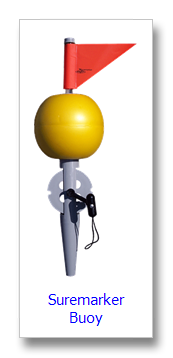
Now onto the dive. Making a buoy dive is easiest when the seas are calm. Here’s how it works. We find the site using the boat’s GPS. Once over the top of it, we throw in a weighted line that has a buoy that floats on the surface. Some buoys are very simple with 90’-100’ of line tied to the weight and a plastic jug attached to the other end. The weight needs to be enough to keep the plastic jug from pulling the weight along the bottom. The downside to this type of buoy is that you need separate buoys for different depths as the amount of line is premeasured.
We use one that has a line reel attached to the surface float and a weight attached to the end of the line. When the weight hits the bottom, the reel is stopped and held in place by a cog. The reel has a few hundred feet of line on it and can be used on any of the depths that we dive from our boat. After the buoy is in place, the divers suit up and the boat is brought near the buoy. The divers enter the water and follow the buoy line to the bottom. They return following the buoy line to the surface. The boat waits nearby to pick us up after the dive.

With everything in place, my dive buddy, Beth Dalzell of Brick, New Jersey and I headed to the bottom. My wife, Veronica, and Beth’s husband, Wes, stayed on the boat waiting to pick us up. We had to additional guests today, Beth and Wes’s niece and nephew, Victoria and Brian Bartlet.
They turned out to be great deckhands.
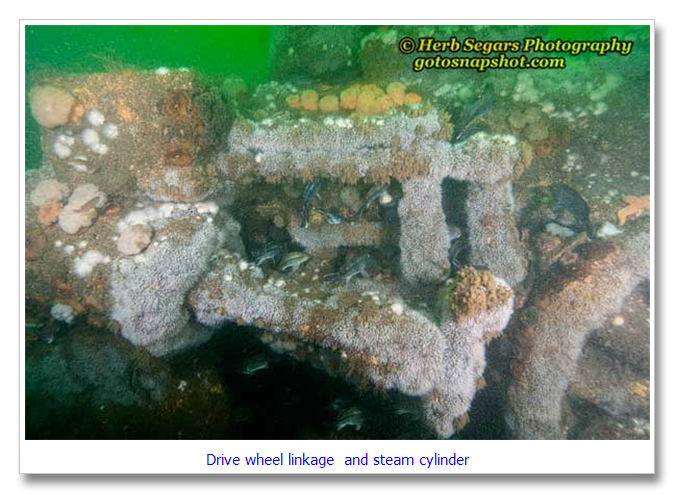
The surface water was murky and kind of a yellowish color. Since this area is not known for great visibility, I was nervous that we had traveled all this way and would end up with no visibility. As we got closer to the bottom, the water got clearer but darker. At the bottom, visibility was about 10’-15’ and the water temperature was 57° F. My first impression upon seeing the first locomotive was “Wow”. It was really an impressive sight! It may not seem that way to everyone but my dive buddy wholeheartedly agreed with me. I couldn’t wait to get my camera and strobes adjusted and start shooting.
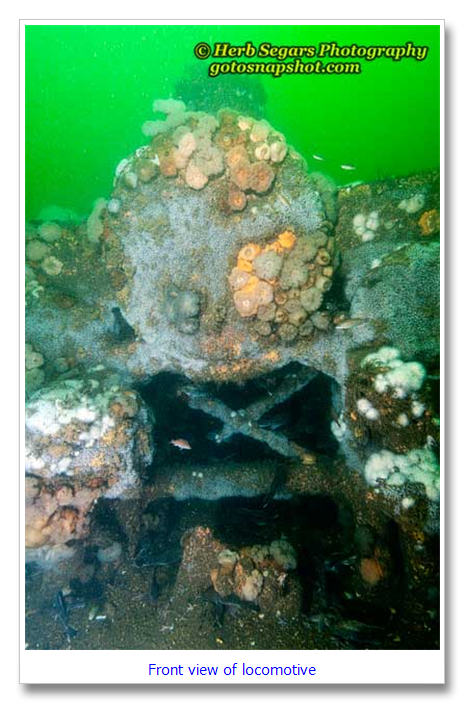
The locomotives were covered with life. There were frilled anemones, lined anemones and blue mussels. There was a great number of black sea bass swimming around both locomotives. I remember coming around the front of the one on the left side and seeing a school of forty or fifty black sea bass swim under the locomotive. The wooden engineer’s cabin, the cow catcher and the smoke stack are not there but there is no doubt what these are locomotives when you look at them. I understand after reading about the site on NJScuba.net that there isn’t much left on the locomotives to take as artifacts. We were here to record the locomotives underwater and didn’t look that close.
I started at the front of the left hand engine and worked my way along the side photographing the drive wheel, the drive wheel linkage and the steam cylinder and finally made my way to the rear of the engine where I photographed the rear of the boiler and the wheel assembly that once held the coal hopper. I moved forward and took some photos of the front of the locomotive so that more of it could be seen in one photo. From the front, you can see the front wheel suspension beneath the boiler.
While I was taking photos, Beth was just looking around. She found the locomotives to be really impressive. She was also impressed with the number of fish that we saw and also with the amount of growth.
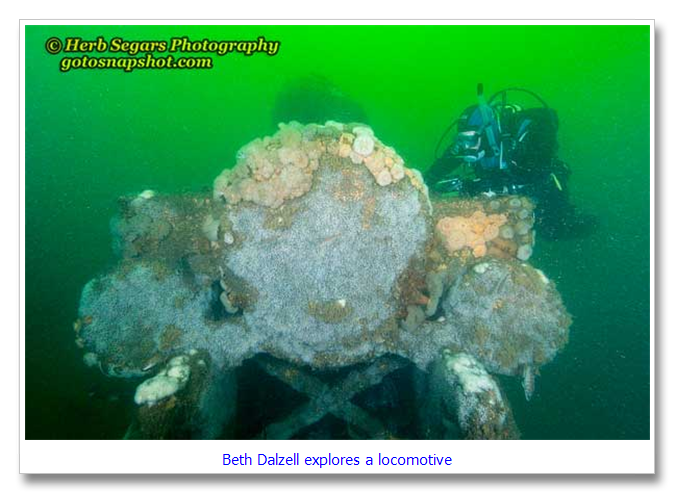
Let’s remember that I am looking at the locomotives from an underwater photographer’s prospective. I don’t get many chances to dive on a site like this so I was very excited. For the normal diver, this is probably not a very interesting dive. After the initial impression of awe recedes, the next thought is going to be “what am I going to do for the rest of my dive?”. That wasn’t a problem with me. I shot nearly 200 photos during my dive and I was a happy person. By the way, I never did see the laminated plaque that should have been brought down to warn divers from taking things that they shouldn’t.
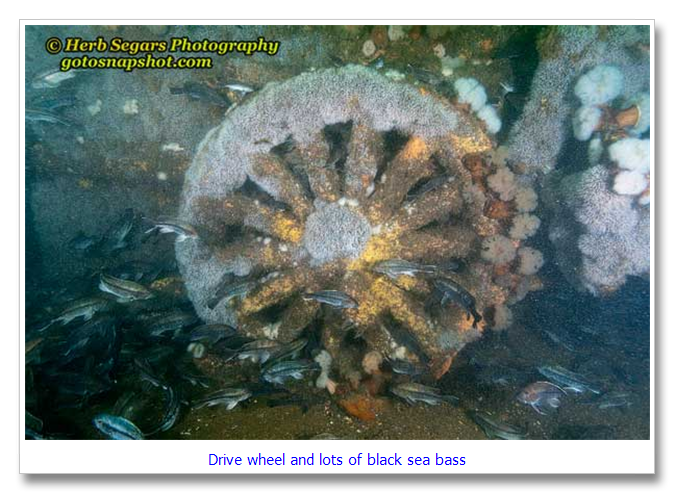
I would like to give credit to the people who found these locomotives. They are Paul & Ruth Hepler. Paul is the Captain of the Venture III out of Belmar, New Jersey. You can find out more information about Paul and the Venture III here. Paul and Ruth are two of the best people that you could ever meet. We have been friends since my son, Tom, was really small. We used to dive from Paul’s boat and we brought Tom whenever we could. I had the chance to talk to Capt. Bob Nash about the locomotives. He said that he was with Paul and Ruth when they made their first dive here. It was a real exciting find for them.
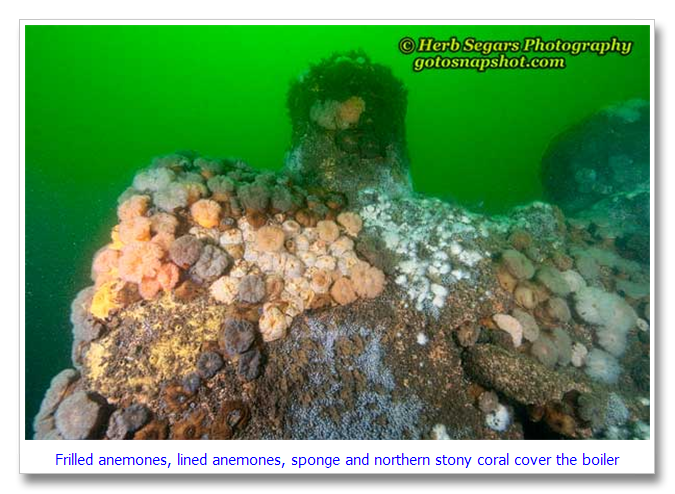
Time goes by fast on the bottom when you are having fun and I was. Before I knew it, it was time to make our way up the buoy line and back to our boat, Snapshot. Veronica, Wes, Victoria and Brian were waiting and it is always good to be back aboard safely. The wind had picked up a little from the south and we decided to stop at the Pinta, a freighter that lies in 80’+ of water about three miles from the locomotives.
I usually like diving the Pinta but today the visibility was pretty bad. It was only about ten feet and the Pinta is so big that it is easy to get lost on it. I didn’t bring a dive reel so I stayed close to the anchor line. I shot some photos despite the visibility.
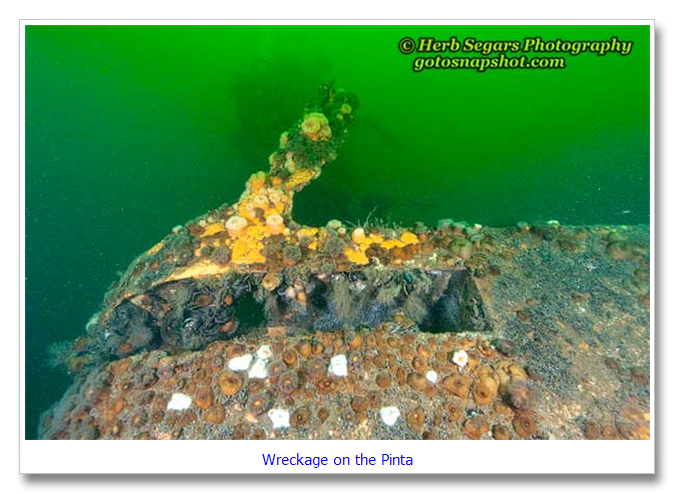
Soon it was time to leave and the wind was now blowing pretty good out of the south. It was going to be a wet ride home. I am not going to write a separate blog about the Pinta dive as there isn’t much to say. Beth and I talked on the way back and we both agreed that despite the majesty of seeing the locomotives, it is not a site that we will be back to very soon. There are still so many things that I want to shoot in my summer of wide angle and I am glad that the locomotives are now crossed off my list. To see more photos of the locomotives, please visit my Photo Gallery and look under Shipwrecks – New Jersey or go directly to the locomotives by clicking here. You can see photos from the Pinta here.
© 2009 – 2010, Herb Segars. All rights reserved.


INTERESTING…..GREAT DETAILS. LEARNED A LOT. I GUESS IT IS NEVER TO OLD TO LEARN FROM A 72 YEAR OLD FISHERMAN. DOCKED IN BELMAR MARINA. GOOD JOB. OGGIE